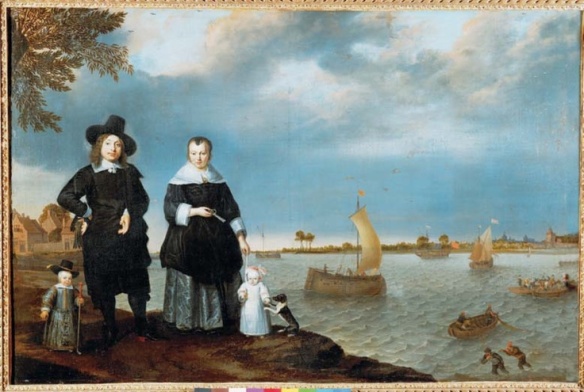
A Portrait of a Dutch Merchant. Although Dutch merchants were among the most successful traders in the seventeenth century world, the austerity of their clothing reflected their Calvinist religious beliefs. Here a shipowner and his family are shown with the trading vessels that provided them with great wealth. (Musée des Beaux-Arts, Valenciennes, France/Erich Lessing/Art Resource, NY)
Early Dutch trading ventures in Europe and the Atlantic were often very profitable, but merchants could be financially ruined if violent storms sank their ships or if pirates stole their cargo. To spread the risk they developed joint-stock companies, a new form of business enterprise based on the sale of shares to multiple owners. In addition to helping investors avoid bankruptcy if a single venture failed, the joint-stock system allowed men and women of small means to buy a few shares and reap a modest profit with little risk.
The development of joint-stock companies put the Dutch at the forefront of early modern commercial capitalism. The development of financial institutions such as banks, stock exchanges, and insurance companies increased the efficiency with which capital could be accumulated and invested. Rather than simply look for a single big windfall that would allow them to retire in comfort, investors now looked for more modest but regular gain through shrewd reinvestment of their profits. This dynamic of using profit for reinvestment and further profit was at the core of the new capitalist ethos associated with the bourgeoisie, the rising social group in Amsterdam and other urban areas of western Europe in the seventeenth century. The bourgeoisie based their social and economic power, and their political ambitions, on ownership of property rather than inherited titles.
Dutch culture reflected the rise of this commercially dynamic bourgeoisie. In many cultures trade was a low-status activity, it being assumed that a merchant could only be rich if he had made someone else poor. Seeking higher social status for their families, successful merchants in cultures as diverse as Spain and China would often use their assets to educate their sons to be “gentlemen” (in Spain) or members of the “literati” (in China). In Holland, by contrast, the leading citizens were all involved in trade, and commerce was seen as a noble calling.
The greatest of the joint-stock companies, and the largest commercial enterprise of the seventeenth century, was the Dutch East India Company, founded by a group of Amsterdam merchants in 1602. The government of the Netherlands granted a charter to the company giving it a monopoly on Dutch trade with Asia. As a “chartered company,” the Dutch East India Company was also granted administrative and military responsibilities overseen from their headquarters in Batavia in what became the Dutch East Indies (today’s Indonesia). In the coming centuries other European powers would copy the Dutch model and use chartered companies of their own to extend their national interests.
Dutch capitalism was not based on free-market principles. The Dutch East India Company was a heavily armed corporate entity that maintained its monopoly through force. “Trade cannot be maintained without war,” said one governor of the East India Company, “nor war without trade.” The Dutch thus repeated the Portuguese pattern of using military force in the Indian Ocean to secure commercial profit, while at the same time introducing modern business and administrative techniques that made them more efficient and effective.
The Portuguese were no match for Dutch competition. In addition to their commercial innovations, the Dutch had made major advances in ship design and construction. In 1641 they took Malacca, the strategic choke point for Southeast Asian trade, from the Portuguese. They became a power in South Asia after they took the island of Sri Lanka (south of India) in 1658. The Dutch presence in Africa was focused on the settlement of Cape Town, established at the far southern tip of the continent in 1652. The fort at Cape Town was built to supply passing Dutch ships with water, meat, brandy, and fruit. At the other end of this vast oceanic expanse, ships of the Dutch East India Company made annual calls at the Japanese port of Nagasaki.
The Dutch East India Company made huge profits, especially from the spice trade. Sometimes they violently intervened in local affairs to increase production, as on the Bandas Islands, where they removed most of the local population and replaced them with slaves drawn from East Africa, Japan, and India to grow nutmeg. The estimated rate of profit ranged from several hundred to several thousand percent. Investors back in Holland were delighted.
The Dutch were lucky that at this time the entire Indian Ocean economy was being stimulated by the introduction of large quantities of American silver being mined by the Spanish in South America and shipped across the Pacific. In fact, the increased supply of silver into China and the Indian Ocean trade networks in the late sixteenth and early seventeenth centuries probably had a greater effect on those economies than the activities of European merchants. Still, the Dutch, with their efficient business organization and shipping infrastructure, were in an ideal position to profit from this development.